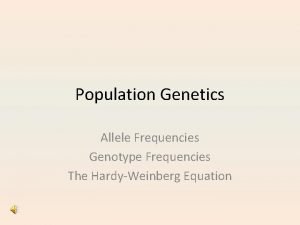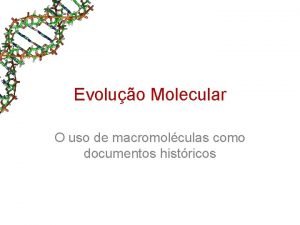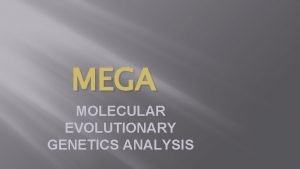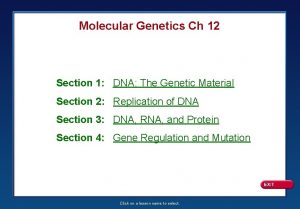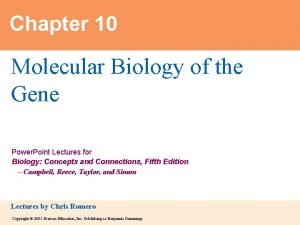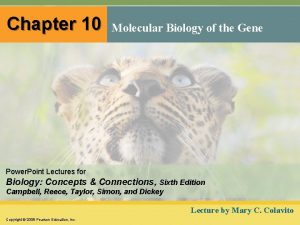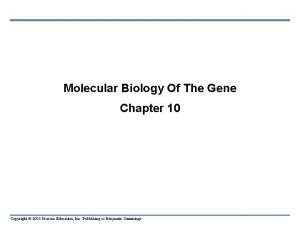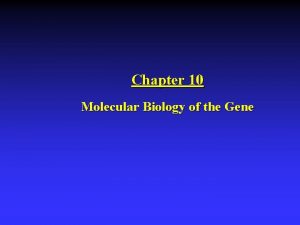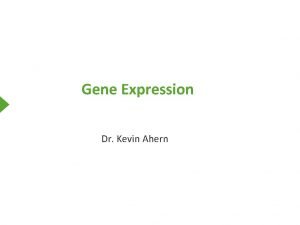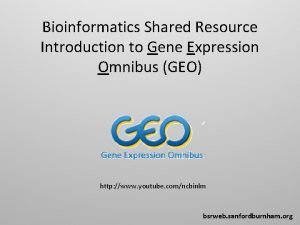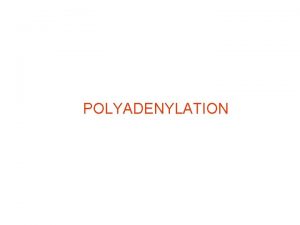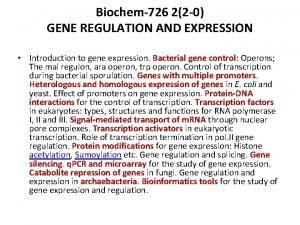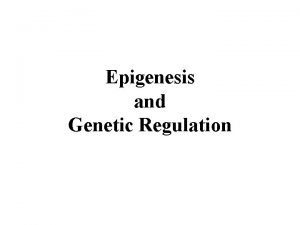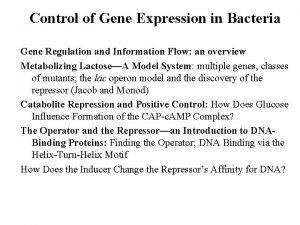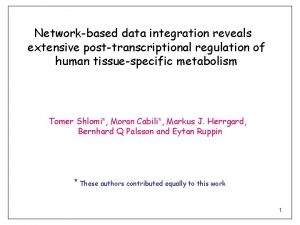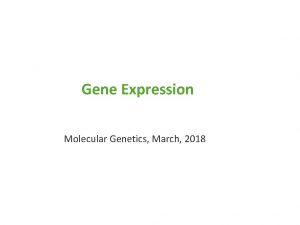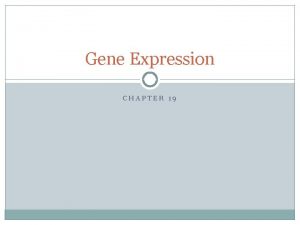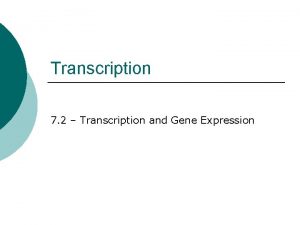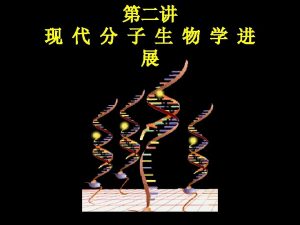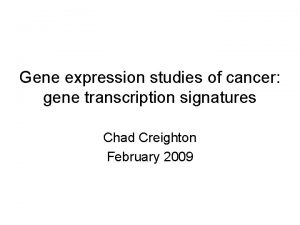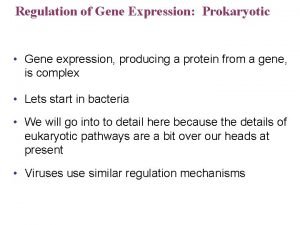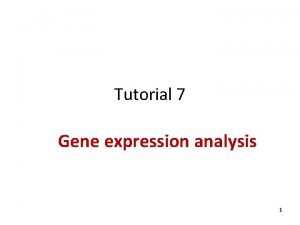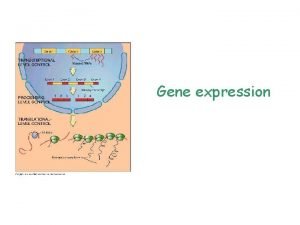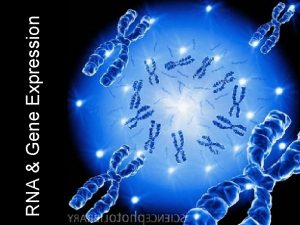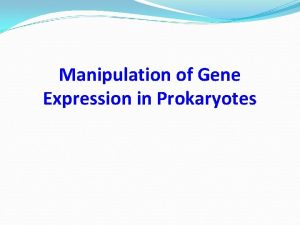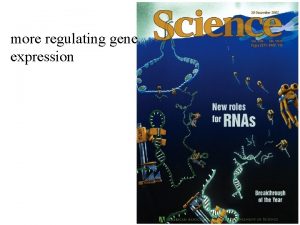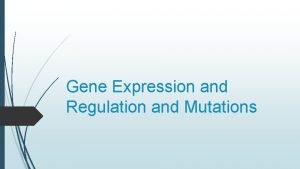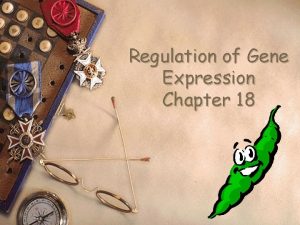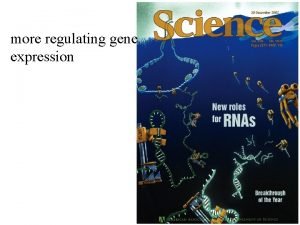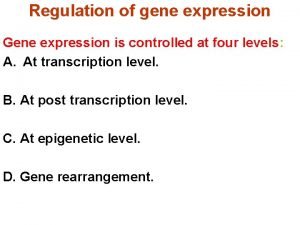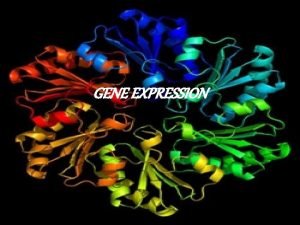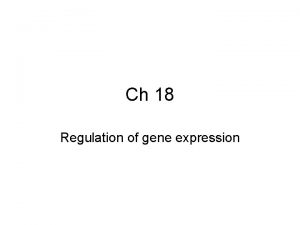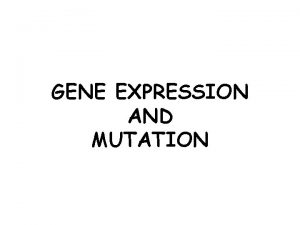8 The Molecular Genetics of Gene Expression Transcription























- Slides: 23

8 The Molecular Genetics of Gene Expression

Transcription Elongation Fig. 8. 6 c 2

Transcription Initiation • Promoter = nucleotide sequence 20 -200 bp long—is the initial binding site of RNA polymerase and transcription initiation factors Fig. 8. 8 3

Transcription Termination Fig. 8. 9 4

Prokaryotic Transcipts DNA 5

What’s different about transcription in eukaryotes? • Multiple RNA polymerases • 5’ capping • Splicing, 1 gene/transcript • Poly. A tail 6

Multiple RNA Polymerases • RNA polymerases are large, multisubunit complexes whose active form is called the RNA polymerase holoenzyme • Bacterial cells have only one RNA polymerase holoenzyme, which contains six polypeptide chains • Eukaryotes have several types of RNA polymerase • RNA polymerase I transcribes ribosomal RNA. • RNA polymerase II - all protein-coding genes as well as the genes for small nuclear RNAs • RNA polymerase III - t. RNA genes and the 5 S component of r. RNA 7

5’ Cap Following initiation a 7 - methylguanosine is added to the 5’-end of the primary transcript = cap 8

Splicing • RNA splicing occurs in nuclear particles known as spliceosomes • The specificity of splicing comes from the five small sn. RNP—RNAs denoted U 1, U 2, U 4, U 5, and U 6, which contain sequences complementary to the splice junctions 9

Splicing 10

Adding a Poly. A tail 11

Eukaryotic RNA processing events 12

Translation • The translation system consists of five major components: § Messenger RNA: m. RNA is needed to provide the coding sequence of bases that determines the amino acid sequence in the resulting polypeptide chain § Ribosomes are particles on which protein synthesis takes place § Transfer RNA: t. RNA is a small adaptor molecule that translates codons into amino acid § Aminoacyl-t. RNA synthetases: set of molecules catalyzes the attachment of a particular amino acid to its corresponding t. RNA molecule § Initiation, elongation, and termination factors 13

Ribosomes t. RNA 2 dimensional 3 dimensional 14

Translation Elongation 1) 2) 3) 15

Translation Initiation 1. ) Small subunit binds to a ribosome binding site 2. ) methionine charged t. RNA binds to the Psite on the ribosome 3. ) the large subunit tops it off…. This brings you to the first step of elongation 16

Translation Termination 17

Translation • The m. RNA is translated in the 5’-to-3’ direction. The polypeptide is synthesized from the amino end toward the carboxyl end • Most polypeptide chains fold correctly as they exit the ribosome: they pass through a tunnel in the large ribosomal subunit that is long enough to include about 35 amino acids Emerging from the tunnel, protein enters into a sort of cradle formed by a protein associated with the ribosome: it provides a space where the polypeptide is able to undergo its folding process. The proper folding of more complex polypeptides is aided by proteins called chaperones and chaperonins • • 18

Translation • The m. RNA in bacteria is often polycistronic (encodes serveral genes), each protein coding region is preceded by its own ribosome -binding site and AUG initiation codon • The genes contained in a polycistronic m. RNA often encode the different proteins of a metabolic pathway. 19

What’s different about translation in eukaryotes? • Initiation does not occur at a Shine Delgarno sequence. The ribosome assembles at the 5’ cap and translocates to the initiation codon 20

Genetic Code • The genetic code is the list of all codons and the amino acids that they encode • Main features of the genetic code were proved in genetic experiments carried out by F. Crick and collaborators: • Translation starts from a fixed point • There is a single reading frame maintained throughout the process of translation • Each codon consists of three nucleotides • Code is nonoverlapping • Code is degenerate: each amino acid is specified by more than one codon 21

Genetic Code • Most of the codons were determined from in vitropolypeptide synthesis • Genetic code is universal = the same triplet codons specify the same amino acids in all species • Mutations occur when changes in codons alter amino acids in proteins 22

23
 Chapter 17 gene expression from gene to protein
Chapter 17 gene expression from gene to protein Allele vs genotype
Allele vs genotype Gene by gene test results
Gene by gene test results Chapter 12 section 1 molecular genetics answer key
Chapter 12 section 1 molecular genetics answer key Arvore filogenetica
Arvore filogenetica Chapter 12 section 1 molecular genetics answer key
Chapter 12 section 1 molecular genetics answer key Chapter 12 section 1 dna the genetic material
Chapter 12 section 1 dna the genetic material Mega molecular
Mega molecular Molecular genetics chapter 12
Molecular genetics chapter 12 Biologists search the volumes of the human genome using
Biologists search the volumes of the human genome using Pap protein synthesis worksheet
Pap protein synthesis worksheet Chapter 10: molecular biology of the gene
Chapter 10: molecular biology of the gene Molecular biology of the gene chapter 10
Molecular biology of the gene chapter 10 Molecular biology of the gene chapter 10
Molecular biology of the gene chapter 10 Chapter 10 molecular biology of the gene
Chapter 10 molecular biology of the gene Genetic effects on gene expression across human tissues
Genetic effects on gene expression across human tissues Prokaryotic
Prokaryotic Gene expression omnibus tutorial
Gene expression omnibus tutorial Gene expression
Gene expression Regulation of gene expression
Regulation of gene expression Lyonization of gene expression
Lyonization of gene expression What is negative control
What is negative control Regulation of gene expression
Regulation of gene expression Gene expression
Gene expression

